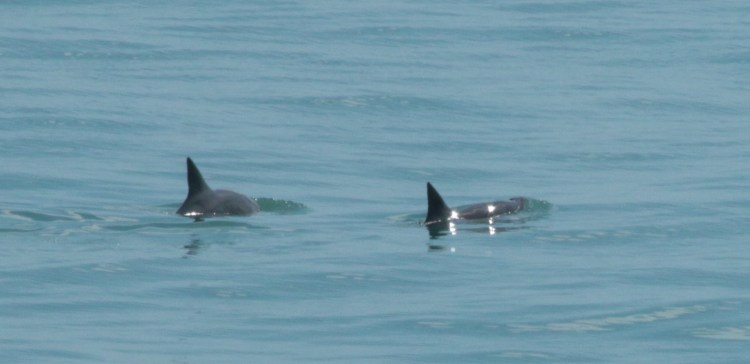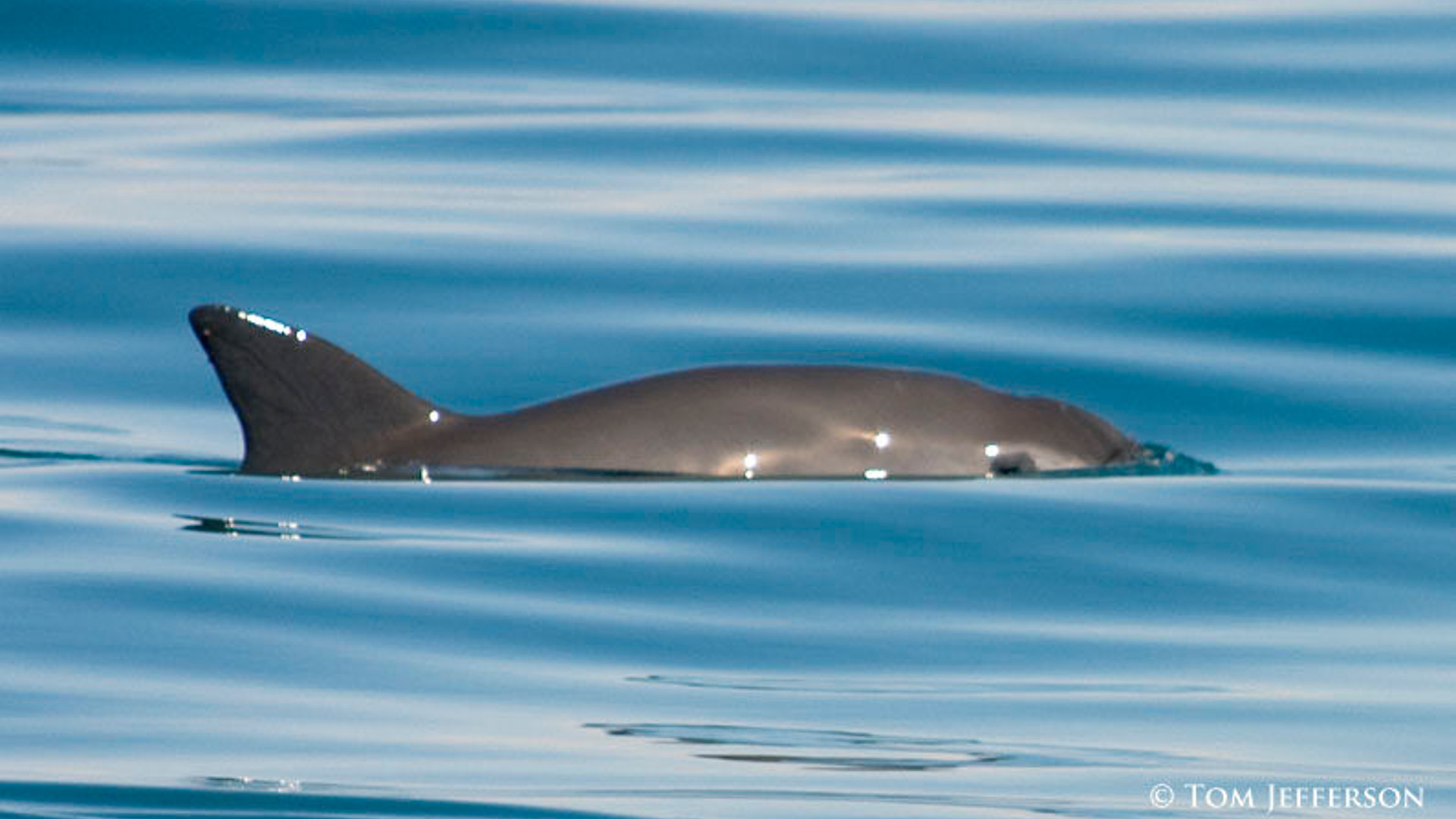Six months: That’s how much time Mexico now has to report on its progress to save the critically endangered vaquita porpoise (Phocoena sinus) from extinction.
It’s a time-sensitive deadline. After years of decline, as few as 6 to 19 vaquitas survive in their only home, the Gulf of California. Also known as the Sea of Cortez, the gulf lies between mainland Mexico and Baja California — and the porpoises’ population there has slowly but steadily been wiped out over the past decade. First these gentle, blunt-faced porpoises were killed by shrimp fishermen, who accidentally caught the “sea cows” in their large gillnets. More recently they’ve fallen to poachers seeking a rare fish called the totoaba (Totoaba mcdonaldi).
Totoaba swim bladders sell for up to $20,000 each in China, where they’re considered a delicacy and are used in traditional medicine. The bladders are frequently smuggled through the United States before heading to Asian consumer markets.
With transnational criminal cartels leading the totoaba poaching and distribution, and with time running out for vaquita, the future for both species “looks very bleak indeed,” says Richard Thomas, global communications coordinator for TRAFFIC, an NGO focusing on wildlife trade.
Conservationists have urged Mexico to protect the vaquita for years, and the country and its allies have taken many steps along the way, but the species’ population has continued to decline. As a result the international community has now finally put a bit of real pressure on the Mexican government. According to an agreement established this August at the 18th triennial meeting of the member parties to the Convention on International Trade in Endangered Species (CITES), Mexico, in collaboration with the U.S. and China, must now work to eliminate both the supply and consumer demand for totoaba and support a program to remove destructive gillnets from the fishery in the Gulf of California. The three nations promised to meet about these goals in the next few months.
“Urgent measures include maintaining net-free zones, round-the-clock patrolling of these areas with removal of all gillnets — and protection for those carrying out these tasks — and arrest and prosecution of illegal fishers,” says Thomas.
Mexico, meanwhile, must improve its enforcement of existing laws by Nov. 30 and report on its progress to the CITES Secretariat every six months. The first report will be due in early 2020.
#Vaquita & #Totoaba #CITESCoP18 Mexico US & China agreed Parties would eliminate supply & demand & support gillnet retrieval programs/by 30Nov Mex to deploy authorities w/seizure & arrest powers & prevent fishers&vessels in Refuge & establish trilateral enforcement group & more
— Ivonne Higuero (@ivonnehiguero) August 26, 2019
“Mexico took this, I think, with a lot of commitment, but also wanted the other parties to recognize the efforts that have been done in the country as well,” says Adrian Reuter, Latin American wildlife trafficking coordinator at the Wildlife Conservation Society. “It’s not that Mexico had done nothing — there’s a long, long list of things they have done — but obviously it’s been insufficient.”
If these new efforts don’t roll out fast enough, or if vaquita continue to die, Mexico could conceivably face international sanctions that would prevent it from exporting some of its most profitable native plants or animals, specifically those species currently listed on what’s known as CITES Appendix II.
CITES, an international treaty covering wildlife trade among 183 member nations, protects threatened species by placing them on two lists that regulate trade. The first, Appendix I, bans all international trade in endangered plants and animals. The second, Appendix II, allows trade, but only of specimens from proven-sustainable populations.
Blocking Mexico from legally exporting its Appendix II species — a step advocated for by several conservation organizations in the lead-up to CITES — is actually a pretty significant threat. More than 2,300 Mexican plants and animals appear on CITES Appendix II, including some coveted species and products such as bighorn sheep hunting trophies, mahogany wood and shark fins.
Other species on the list include boa constrictors, iguanas, corals, spider monkeys and dozens of kinds of orchid.
CITES sanctions, however, don’t happen very often. One of the few noteworthy examples occurred in 2013, when CITES threatened to sanction Thailand if the country didn’t reduce the amount of illegal ivory for sale there. (The threat worked, by the way. The amount of ivory available in Bangkok markets dropped 96 percent by 2016.)
But progress for the vaquita will be much tougher to achieve because of the violent cartels dominating the trade. “The vaquita and the totoaba are a good example of how things can go really, really bad for biodiversity when the commodity is really high-value and organized crime gets involved,” says Reuter.
“It’s a big, big challenge,” he adds. “As we know, the totoaba bladder trade involves transnational, highly organized networks. It’s a high-value commodity. It requires actions being taken like for addressing any other serious crime committed by organized cartels and organizations. Sometimes that’s difficult because it requires lots of resources, staff and coordination that — in many instances, not just in Mexico but in many other countries in the region — are not available to tackle environmental crimes.”
With the time for action growing increasingly tight, will we see any progress on saving the vaquita from extinction? Reuter says he’ll be watching to see what happens by the end of the year, especially to find out if the proposed meeting between Mexico, the United States and China actually takes place. “If it does, it would be a very good forum to follow up on what happened,” he says.
Meanwhile there’s both good news and a stark reminder about the need for action. Last month the Sea Shepherd Conservation Society reported that scientists had, over the course of a few weeks, observed six vaquitas in the Gulf of California, an important confirmation that the animals still exist. “It is excellent to see these vaquitas are well fed, plump and healthy looking,” vaquita researcher Barbara Taylor said in a press release. “This invigorates the resolve for Mexico to protect their species.”

Next, 600 Mexican antipoaching troops are scheduled to arrive in the region soon to enforce a “zero tolerance” fishing policy in the vaquita’s habitat.
But those troops may find themselves in the midst of a renewed struggle with local fishermen. Mexico has paid shrimp fishermen to stay out of vaquita habitat since 2015, but those compensation funds reportedly stopped arriving last December, after President Andrés Manuel López Obrador took office. With fishermen now struggling to feed their families, their leaders say fleets could resume operation any day. “We know about the vaquita, and we’ve done what we can, but we have needs and we have to work,” Lorenzo Garcia, president of the region’s largest fishermen’s federation, told Fronteras.
Even with the imminent arrival of Mexican soldiers, the resumption of gillnet shrimp fishing in the Gulf of California represents a major shift in vaquita conservation efforts. Will it push the tiny porpoises closer to disappearing? The world will be watching.
![]()



1 thought on “Saving the Vaquita: New Promises and New Threats”
Comments are closed.